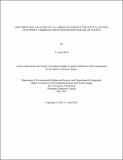| dc.contributor.author | Wolf, Z. Uriah | |
| dc.date.accessioned | 2023-07-19T22:23:39Z | |
| dc.date.available | 2023-07-19T22:23:39Z | |
| dc.date.issued | 2023-05 | |
| dc.identifier.citation | Wolf, Z. Uriah. Spectroscopic Analysis of Ca-Carbonates from Utah Crystal Geyser to Support Carbonate Detection within our Solar System; A thesis submitted to the Faculty of Graduate Studies in partial fulfillment of the requirements for the ... Master of Science in Environmental Science and Social Change. Winnipeg, Manitoba, Canada: The University of Winnipeg, May 2023. DOI: 10.36939/ir.202307041523. | en_US |
| dc.identifier.uri | https://hdl.handle.net/10680/2090 | |
| dc.description.abstract | This study investigated the Utah Crystal Geyser, a unique low-temperature, CO2-rich geyser relevant to Mars, icy moons, and asteroids. Samples from the site had a range of textural and color differences; however, they contained similar mineral assemblages dominated by carbonates (calcite and aragonite). The identification of calcite and aragonite is important as they can be biogenically produced and possess the ability to preserve biogenic fingerprints and entomb microbial fossils. This analysis confirmed that the most effective method for identifying and distinguishing calcite and aragonite is through a combination of several techniques. Specifically, reflectance spectroscopy was able to determine the presence of calcite-aragonite mixtures. However, it could not effectively differentiate between the two since the band positions and shapes change subtly with varying abundances of the two carbonates. Thus, it can only be stated that a mixture is present, and the degree to which transformation from aragonite to calcite has proceeded is poorly constrained. Raman spectroscopy was able to identify both calcite and aragonite and could differentiate between the two through diagnostic peaks in the low Raman-shift region of the spectrum. Scanning electron microscopy imaging provided sub-micrometer images of textures and sedimentary fabric, such as laminations, crystal structures, and entombed microbial fossils. X-ray diffractometry and X-ray fluorescence were used to determine and verify the mineralogy of the samples. The low-temperature origin of these carbonates is likely the factor responsible for the lack of homogeneity within the samples. Carbon dioxide degassing is likely the primary factor supporting the precipitation of aragonite at the geyser, despite the low temperature. The results have implications for carbonate detection and characterization on Mars and the recognition of low-temperature carbonate precipitates on a number of planetary bodies. | en_US |
| dc.description.sponsorship | "This study was supported by the Canadian Space Agency (grant 22 EXPCO14), the Natural Sciences and Engineering Research Council of Canada (grants RGPIN-2021-02995 and RTI-2020-00157), the Canada Foundation for Innovation, and the Manitoba Research Innovation Fund (grant #CFI 1504), and the University of Winnipeg." | en_US |
| dc.language.iso | en | en_US |
| dc.publisher | University of Winnipeg | en_US |
| dc.rights | info:eu-repo/semantics/openAccess | en_US |
| dc.subject | Calcite | en_US |
| dc.subject | Aragonite | en_US |
| dc.subject | Astrobiology | en_US |
| dc.subject | Biosignatures | en_US |
| dc.subject | Perseverance rover | en_US |
| dc.subject | Mars spectroscopy | en_US |
| dc.title | Spectroscopic Analysis of Ca-Carbonates from Utah Crystal Geyser to Support Carbonate Detection within our Solar System | en_US |
| dc.type | Thesis | en_US |
| dc.description.degree | Master of Science in Environmental Science and Social Change | en_US |
| dc.publisher.grantor | University of Winnipeg | en_US |
| dc.identifier.doi | 10.36939/ir.202307041523 | en_US |
| thesis.degree.discipline | Environmental Studies and Sciences | |
| thesis.degree.discipline | Geography | |
| thesis.degree.level | masters | |
| thesis.degree.name | Master of Science in Environmental Science and Social Change | |
| thesis.degree.grantor | University of Winnipeg | |

